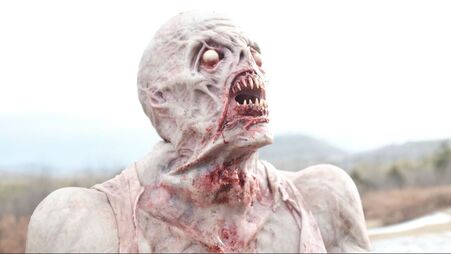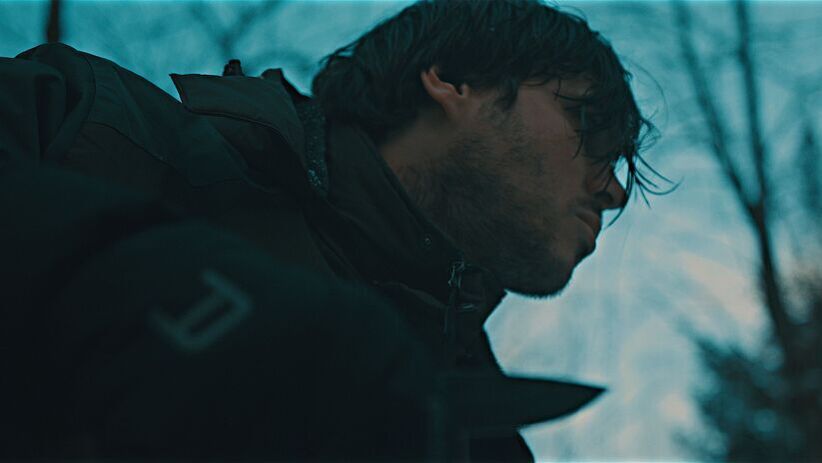 Indulging in recreational substances is pretty commonplace amongst bachelor parties, but when that bachelor party is high atop a freezing cold mountain and that substance is a strange hallucinogenic tea, things are a bit more unpredictable... ...What they discover up there is even more puzzling. I’ve always been fascinated by folklore, cryptids, and things that go bump in the night, so when I discovered writer/director Bruce Wemple’s new project would feature the mythological entity known as the “Wendigo”, I was hooked. The origin of the Wendigo goes back to the indigenous people of Canada; it’s said they are malevolent spirits that have the power to invoke murder, insatiable greed, and cannibalism. Wemple is no stranger to these psychological terrors, as many of his films explore the darkest corners of the human psyche. It’s all fascinating stuff but scaring audiences with psychological horror is a towering mountain in and of itself. Gus (Grant Schumacher) has been tasked with organizing a bachelor party for his best friend, Adam (Dylan Grunn). Adam’s request is simple: the two of them going on a weekend hike into the Adirondack Peaks. Like any respectable best man would do, Gus makes it happen and they head off on their frigid upward trek. Once they’ve stopped for the day and are enjoying a camp side fire, Gus offers Adam a hallucinogenic tea to celebrate their hike and his upcoming marriage. While Adam only has a sip, Gus drinks nearly all of it. What comes after this moment is a blur of strange events for Gus. One moment he is witnessing a terrible self-inflicted tragedy and the next it’s as if nothing happened. The one consistent thing Gus has to cling to is the reoccurring ominous presence of a dark figure looming in the woods, staring him down. Gus’ manipulated realities worsen with time and he desperately tries to maintain some semblance of sanity before losing his mind permanently. Unlike popular cryptids like Sasquatch or the Chupacabra, the Wendigo is not purely a physical threat, but one that preys on human vulnerability and perception. It draws parallels to the Mothman urban legend, which also deals with psychological impairment and distorted realities. Getting under the skin of viewers with such ambiguous threats is a challenge, but for the most part, Wemple pulls it off. The corrosion of Gus’ grip on reality is chilling. He winds up in several different versions of his reality and in each one, the Wendigo is present. The manifestation itself is mostly terrifyingly silent, with intense watchful eyes. On several occasions, Gus will peer across the sea of snow-dusted trees and notice a black mass in the distance. Other times, that mass is much closer and illuminated only by its glowing eyes. These moments are truly unsettling, but there are other moments that aren’t as convincing. One of the first shots we see of the Wendigo is entirely too close and reveals their physical form. It kills the suspense in a film where less is more. I wish Wemple had chosen one vision to go with, because the merging of ambiguous shadow beings and full-fledged monsters just doesn’t work. Even with that being said, the moments that work are severely unnerving and offer a great sense of dread. At first, I was very put off by Gus, as he is very possessive over Adam and clearly has deep seated reservations about Adam’s wedding. I wondered why our central character was so unlikable, but that’s exactly what the Wendigo feed on. Gus is a terribly flawed person and is immediately off-putting, but after you witness the complete breakdown of his mental faculties, you start to feel for his situation. I don’t think he’s a character you ever root for, but you definitely want to see an end to his suffering. Much of the character’s effectiveness is due to Schumacher’s incredible performance. He basically cycles through every human emotion (in a broad sense at least) and my sympathies for him as a character never felt forced onto me. He’s not trying to win the audience over and I think Schumacher had a great understanding of Gus and his internal demons. Grunn does a fine job as Adam, although not much is required of him. Of course, this is no fault to him, I just think his character was more of an idea or concept than a fleshed-out person. This works in the film because, ultimately, it’s Gus who is unstable and fallen victim to the Wendigo forces. Other than the odd coupling of contradictive Wendigo imagery, my only complaint is the ending. I fully accept the film as more theme and mood based than one that offers concrete answers to our questions, but a little context can go a long way. The Retreat, however, expects us to surmise what’s really going on with very little explanation. I don’t think it breaks the film, but by the end I expected at least a few of my questions to be answered. Instead it resorts to an all too familiar horror trope. To be blunt, it feels quite lazy. Still, the story pulls you in and Gus’ journey is gripping enough to make you sympathize with a pretty unlikable character. The Retreat ends up getting more right than wrong with its intended effect. This is a must see for fans of folklore, urban legends, and anyone craving what is essentially a feature length Creepy Pasta. The Retreat comes to Digital and DVD from Uncork’d Entertainment November 10th. By Jeffrey W. Hollingsworth
1 Comment
Jackie Daytona
11/9/2020 01:55:30 pm
Not nuf bangin’
Reply
Leave a Reply. |
Archives
March 2023
|


 RSS Feed
RSS Feed